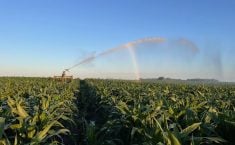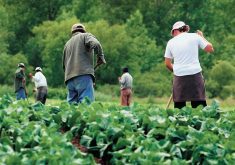The new $508-million agriculture funding deal between Ottawa and the provincial government is getting mixed reviews.
“Overall it’s a pretty good framework,” said Alberta Canola vice-chair Ian Chitwood. “From Alberta Canola’s perspective, we really support it. It’s a pretty well-rounded suite of programs so I think it’s going to be good for producers.”
But as its name suggests, the Sustainable Canadian Agricultural Partnership is more focused on the federal government’s environmental priorities than its predecessor, the Canadian Agricultural Partnership or CAP.
Read Also

Moo translator and methane measures: There’s an app for that
Dalhousie University researchers use artificial intelligence to create new dairy farm apps that analyze cattle sounds and measure methane.
That’s not necessarily a bad thing, but Alberta Wheat would have liked to see a greater focus on markets and the grain business, said the group’s senior manager of government relations and policy.
“Our priorities are really around increasing demand for our grain, increasing our production and reducing our risks,” said Shannon Sereda. “There’s always been a component of sustainability in the five frameworks to date but this is definitely a much greener one. It’s right there in the title.”
The chair of Alberta Beef Producers shares both of those views.
While there are a lot of good programs for cattle producers, there’s a gaping hole when it comes to the financial side for his sector — the lack of a price insurance scheme that producers can bank on, said Brodie Haugan.
“We definitely need a risk management program for the beef industry, specifically the cow-calf sector,” he said. “Currently we don’t have one that works to properly mitigate the risk.
“We have been in discussion for many months around the risk management topic, trying to identify different solutions or ideas and looking at areas and at other provinces and even down in the States at programs that they are currently offering, and what works and what doesn’t, trying to identify some of the gaps and what we might be able to change or alter if we were to bring something into Alberta.”
The new funding framework, dubbed Sustainable CAP, is the latest in a series of five-year funding agreements between Ottawa and the provinces and territories. Nationally, this one is worth $3.5 billion, with $1 billion of that being strictly federal money for federal programs and activities.
The remaining $2.5 billion is cost shared on a 60-40 federal-provincial basis and that amount has been increased by $500 million this time around. But half of that increase, Sereda noted, will go to the Resilient Agricultural Landscape Program. It offers individual producers up to $150,000 for “projects on their land that over time can provide significant benefits for the producer, the public and future generations.”
“It’s meant to compensate farmers for their ecological goods and services, which we don’t disagree with,” said Sereda. “The question is whether these programs and priorities should fall under this framework or should be funded separately through other government funding envelopes.”
And there are a lot of these ‘funding envelopes.”
In addition to the Resilient Agricultural Landscape Program (RALP), Alberta producers can tap into Efficient Grain Handling, Farm Technology, Water, and On-Farm Value-Added programs.
There’s also the Emerging Opportunities program, which is earmarked for processors and organizations, with a Value-Added program specifically for the former and the Accelerating Agricultural Innovations targeted to both organizations and producers.
Alberta Canola members seem most excited about RALP and the opportunities it offers them to upgrade their land, said Chitwood.
“It’s in line with the federal government looking at carbon sequestration, climate change and environmental protection. It’s not surprising that would be a big program that would be a focus,” he said.
“That said, that’s sort of the direction producers are going anyway, so it works pretty well.”
Farm Technology will also draw interest from crop producers, Chitwood added, “especially for younger producers or those looking to upgrade equipment. It will allow producers to tap into more of the field mapping programs and tie that into their soil monitoring programs. It’ll really kickstart some of that data piece for producers.”
The program that covers half the cost of specific upgrades for grain dryers is a favourite among Alberta Wheat members, said Sereda.
“The Efficient Grain Handling program is one that has existed previously,” she said. “It’s a good program. Farmers use it and I think it’s been fully subscribed for multiple years. I’m glad to see some additional funding out towards that.”
The Sustainable CAP also renews the old agreement’s suite of business risk management programs: AgriStability, AgriInsurance, AgriInvest and AgriRecovery.
Of these, Sereda is particularly happy about the continuance of AgriInsurance, a program that provides cash flow to help producers manage income declines.
“It remains one of the critical tools that our producers have to manage the production risk they face every year,” she said. “It’s a program that really works. It’s responsive. It allowed farmers to be resilient through the (2021) drought and other extreme weather events.”
AgriStability, a margin-based program designed to help producers manage large income declines, has seen an injection of additional cash, which means an increased compensation level for farmers who sign up.
“So for farmers that are able to trigger AgriStability, that would increase their compensation level from 70 (previously) to 80 per cent,” she said.
The program has seen low participation rates for years. Many farmers say it doesn’t pay out enough, isn’t reliable enough to be bankable and doesn’t work for many types of farms because it provides whole farm coverage and inadvertently penalizes diversified operations.
Even with increased compensation levels, Sereda said she’s not sure Alberta crop producers will take to AgriStability.
“The compensation rate is a positive outcome and something that had been advocated for, but for the crop sector, AgriStability isn’t really the program our farmers depend on in the same sense they do AgriInsurance,” she said. “So it may have varied impact on our sector but that’s to be determined.”
Still, Sustainable CAP puts a lot of money on the table for farmers, said Haugan.
“It’s very positive,” he said. “It’s always good to see funding directed towards our industry.”
Program details can be found at www.alberta.ca/sustainable-cap.aspx. There’s a link to each major program on this page. A helpful document within each program is the “program funding list.” These documents provide a handy list of expenses that are eligible for grants and ones that don’t qualify for funding.
– With files from Alexis Kienlen
















